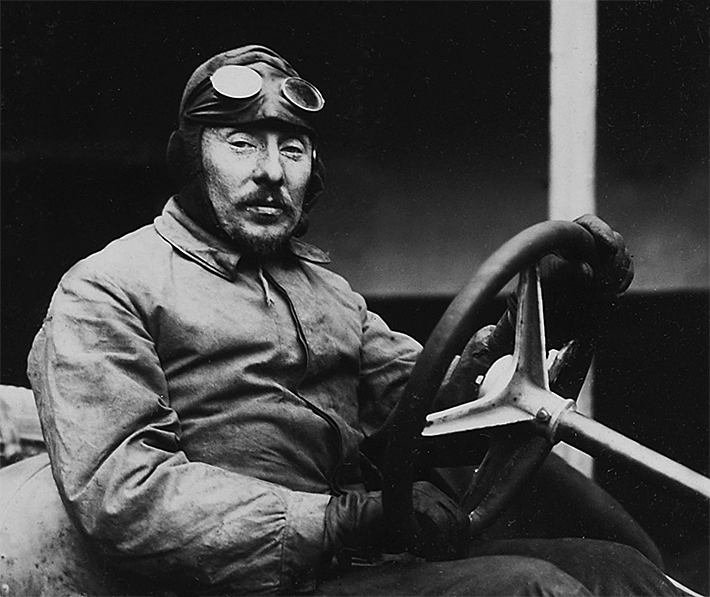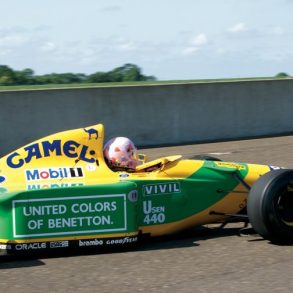Camille Jenatzy Biography
Jenatzy’s family, originally from Hungary had settled in Schaerbeek, Belgium where where his father Constant established Jenatzy – Pneumatic, the first rubber factory in Belgium. In 1865 a son, Camille was born in Brussels. While studying for his civil engineering degree the young Jenatzy entered and won some local bicycle races. France had been a pioneer in lead acid battery technology and in 1881 Charles Jeantaud, assisted by Camille Faure built one of the first commercial electric powered vehicles. Jenatzy like many other prosperous young men of his generation was fascinated by the possibilities of the new motor cars and built a factory, the General Transport Company in France for the manufacture of battery powered vehicles.
Motor racing, as a sport that was exploding in popularity and seemed a natural way to demonstrate the capabilities of an automobile, so Jenatzy entered his first race, the Chantekoup hill climb, in November of 1898. Driving one of his electric cars, Jenatzy set the fastest time of the day, averaging 17 MPH over the muddy 1.8 kilometer course. One of his main rivals, an electric Jeantaud motor car, driven by Count Gaston de Chasseloup-Laubat would set an official land-speed record of 39.2 MPH. Jenatzy promptly challenged his rival to a duel albeit with motor cars.
The duel took place on the 17th of January 1899 on a road just west of Paris in Achères. Jenatzy driving first establishing a new record of 41.4 MPH only to be topped Chasseloup-Laubat again driving the Jeantaud who was clocked at 43.7 MPH. Jenatzy promptly demanded another rematch, to take place in just 10 days’ time. This time, luck would be on his side; Jenatzy posted a new record speed of 49.9 MPH, but Chasseloup-Laubat suffered a burned motor and was unable to complete his run. Back and forth the record was broken and Jenatzy decided he needed to create a purpose built racing car in order to vanquish his rival once and for all.

When asked to describe the feeling of traveling faster than physicians of the day believed the human body could endure, Jenatzy said: “The car in which you travel seems to leave the ground and hurl itself forward like a projectile ricocheting along the ground.” Not everyone was impressed, though. W. Worby Beaumont wrote in his massive Motor Vehicles and Motors: ‘This is without doubt a higher speed than any other human being has ever traveled on roads, but it was only for about three-quarters of a mile that it was maintained. This vehicle was of no use in any way as a guide for any other class of vehicle’.


Note: The above story appears to be in error based upon an interview that Jenatzy conducted with a reporter for the Le Mond Sportif newspaper prior to the Vanderbilt Cup in which Jenatzy relayed the fact that the air tube had been tightly blocked by bees. He remembered that when passing near Angouleme he had driven through an immense swarm of bees. – New York Times – August 2, 1903
Later that year success would finally come to Jenatzy at the Gordon Bennett Cup in Ireland. Ironically he was not originally selected to drive for Mercedes but was a last minute replacement for the original driver who was not considered a proper gentleman by the Deutsche Automobil Club and only gentlemen could take part in the Gordon Bennett. The cars they drove were not originally intended for the race having been requisitioned from customers after the original cars were destroyed in a fire back at the factory. The car driven by Jenatzy was only obtained after several entreaties because the owner’s chauffeur was not convinced that Jenatzy was qualified to drive the car.
On a cool and cloudy day, July 2, 1903, starting at seven minute intervals Jenatzy drove the race of his life on a track riddled with curves and bumps. At the wheel of a car that was inferior in terms of horse power he tailored his spectacular driving style accelerating out of curves.
A fellow participant marveled: “Throughout the seemingly endless series of curves, Jenatzy kept his foot to the floor. He skidded at breakneck speed around the corners, often only narrowly missing the bordering walls in the process, as was shown by his skid marks that were everywhere to be seen. I could not imagine that he could keep up this daredevil driving style for very long.” By the time the race was over the Gordon Bennett Cup was headed back to Germany. Jenatzy for his efforts was awarded $25,000 from Mercedes, a new car worth $17,000 and a further $8,000 from the tire manufacturer for a princely total of $50,000, which would be approximately equivalent to $2.3 mil in 2014!

It was not Jenatzy’s love of fast driving which caused his violent death in 1913, but his propensity for practical joking. According to accounts to the police at the time he was entertaining a party of friends at his shooting box in the Ardennes, and one night decided to frighten them. Jenatzy crept outside, hid behind a bush, and imitated the fearsome grunt of an enraged wild boar. Whereupon one of his guests leaned out of the window and shot the supposed wild animal dead. Rumors at the time identified the shooter Alfred Madoux, director of the journal L’Etoile Belgeas and the husband of Jenatzy’s alleged mistress.




















